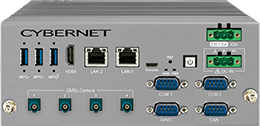Carbon dioxide (CO2) is a significant contributing factor to climate change, which continues to disrupt the lives of millions around the world. Unfortunately, carbon dioxide is also a byproduct of many of our most essential industries, such as fossil fuels, plastic manufacturing, and the creation of building materials such as concrete. Therefore, CO2 capture and utilization is a critical concern for many businesses.
By using industrial computers to monitor and control CO2 capture and utilization processes, manufacturers can reduce their carbon output and protect the environment without negatively affecting their business.
How Does CO2 Capture Work?
CO2 capture, as the name implies, is the process of capturing CO2, either at the site of production or pulling it from the atmosphere. Of the two, capturing the gas at the source is far more efficient.
There are two primary methods for capturing CO2: liquid solvents and solid sorbents.
- Solvent-based systems rely on chemicals that capture CO2 directly from the air. For example, a fossil fuel-burning power plant will have these systems in its exhaust smokestack, as close as possible to the source, to capture the maximum amount of CO2. As the exhaust passes through the solvent, the gas is separated from the rest of the air and later compressed into a liquid form for easier storage.
- Solid sorbent systems use physical filters that chemically bind with CO2 molecules and separate them from other air molecules. In 2019, a team at MIT developed a system of electrochemical plates that absorbs CO2 from the air as it passes over its electrodes and then releases the gas when the electrodes are discharged. This lets workers re-route the gas to storage once it has been captured.
As these systems are often used in harsh industrial working conditions, the computers used to support and control them must be equally durable. Industrial rack mount PCs are ideal for this role, as they can handle harsh vibrations and extreme temperatures without breaking down.
After the carbon dioxide has been captured, it must be stored somewhere permanently. The most common solution is to compress the CO2 into a liquid state and then pump it into a geological formation, such as emptied oil reserves or brackish water reservoirs. These formations are often 2,500 feet below the earth's surface or deeper, making them perfect for storing carbon dioxide.
CO2 Utilization: The Alternative to Storage
But what if we did more with CO2 than just bury it deep underground? This is where carbon dioxide utilization comes into play. CO2 is an unwelcome byproduct in some industries, but it is also a valuable and necessary resource in others. By repurposing carbon dioxide more productively, companies can prevent unnecessary atmospheric contamination.
Industries that currently use CO2 include:
- Farming: Greenhouse farmers use large amounts of CO2 to nourish their plants. As plants naturally consume CO2 and produce oxygen, this helps reduce the amount of carbon dioxide in the atmosphere and increase the amount of oxygen available. CO2 is also a significant component in several types of fertilizer.
- Food and Beverages: CO2 is what gives carbonated beverages their fizziness, making it a ubiquitous resource for soda companies. Beyond that, CO2 is also frequently used in cooling and refrigeration and to displace air during the canning process.
- Manufacturing: CO2 plays a vital role in welding, making the process faster, more efficient, and requiring less cleanup afterwards. CO2 serves as a shielding gas, an inert or semi-inert gas that protects the weld from contact with atmospheric gases that might disrupt the weld's heat or appearance.
CO2 utilization is also being explored for other industries, such as:
- Construction: CO2 is one of the byproducts of producing concrete, the most common building material in the world. Carbon dioxide can be captured and mineralized to add to the concrete mixture or fed back into kilns to recycle the gas and prevent it from leaking into the atmosphere.
- Fuel Industry: Carbon dioxide can be used in the biofuel production process. Biofuels are derived from microbes that consume CO2 for nourishment, allowing the fuel industry to convert a harmful byproduct into a useful resource.
Embracing Carbon Capture and Utilization with Cybernet
The ever-increasing amount of carbon dioxide in our planet's atmosphere is an issue that cannot be ignored. Every industry, large and small, must participate in this effort to reduce carbon emissions by capturing and, wherever possible, reusing CO2 productively.
If you're looking for industrial panel PCs or mini PCs to help your company manage its carbon capture and utilization efforts, contact the team at Cybernet Manufacturing. Our computers are designed with the reliability and processing power needed for carbon capture programs.
Join the conversation and connect with us on this and other relevant topics - Follow us on Facebook, Twitter, Instagram, LinkedIn, TikTok, and YouTube.

